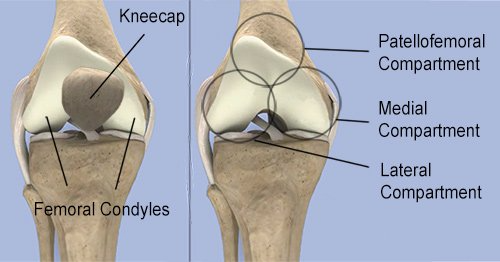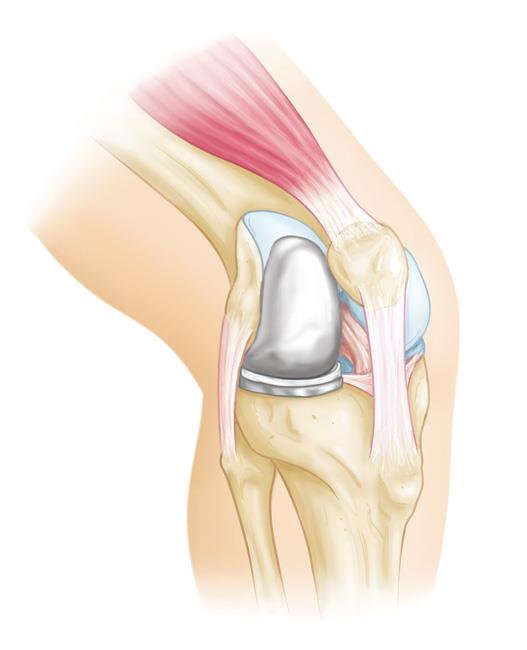Knee
Partial (Unicompartmental) Knee Replacement
Partial (unicompartmental) knee replacement is a less invasive alternative to total knee replacement surgery for patients suffering from knee osteoarthritis. This procedure is designed to treat patients whose knee arthritis affects only one part (or "compartment") of the knee joint, leaving the healthy portions intact. Unlike total knee replacement, which replaces the entire knee joint, unicompartmental knee replacement only replaces the damaged area, preserving the healthy bone, cartilage, and ligaments. This approach offers several benefits, including a quicker recovery and a more natural-feeling knee.
What is Partial (Unicompartmental) Knee Replacement?
The knee joint consists of three compartments: the medial compartment, the lateral compartment, and the patellofemoral compartment. In cases of osteoarthritis, damage often occurs in just one of these areas. Unicompartmental knee replacement (also known as partial knee replacement) is performed when arthritis affects only one of these compartments, while the other two remain healthy. This allows for a more natural range of motion and faster recovery, as only the damaged area is replaced.

Procedure: What to Expect
The surgery begins with a small incision over the affected area of the knee. Through this incision, Dr. Ryan du Sart will remove the damaged bone and cartilage in the affected compartment. This procedure typically involves less tissue disruption compared to total knee replacement, leading to less post-operative pain and a quicker recovery.
Dr. du Sart uses specialised cutting jigs and guides to ensure precise bone removal and optimal joint alignment. Trial components are then inserted to check the accuracy of cuts before the definitive components are placed. The implant components are made from metal and polyethylene, and they are either cemented or press-fit into the bone, depending on the patient's age and bone quality. After the damaged bone and cartilage are replaced, the knee joint is restored with a metal femoral component, a plastic bearing surface, and a metal tibial component.
Benefits of Partial Knee Replacement
There are several benefits to opting for unicompartmental knee replacement, including:
- Faster Recovery: As more of the knee’s natural structures (bone, ligaments, and tendons) are preserved, patients typically experience a faster recovery and can resume walking within 10-14 days post-surgery.
- Smaller Incision and Less Trauma: The smaller incision results in reduced surgical trauma, less pain, and a faster healing time compared to total knee replacement.
- Improved Mobility: With less bone removed, patients often report a more natural-feeling knee and better movement.
- Lower Risk of Complications: There is a lower risk of complications such as deep vein thrombosis (DVT) and infection due to the minimally invasive nature of the procedure.
- Preservation of Healthy Tissue: Only the damaged compartment is replaced, conserving the healthy bone and cartilage.
- Revisions to Total Knee Replacement: If necessary, a partial knee replacement can be revised into a total knee replacement in the future.

Are You a Candidate for Partial Knee Replacement?
Ideal candidates for unicompartmental knee replacement have isolated damage in one compartment of the knee. This is often seen in patients who have:
- Osteoarthritis affecting only one area of the knee
- Healthy ligaments in the knee
- Minimal knee deformity and no significant damage to the knee joint
If the arthritis is widespread or multiple compartments of the knee are affected, a total knee replacement may be recommended.
Dr. Ryan du Sart will assess your condition to determine whether you’re a suitable candidate for partial knee replacement.

Recovery and Rehabilitation
Recovery after partial knee replacement is generally quicker than that of total knee replacement. Here’s what you can expect:
- Pain Management: Post-operative pain is generally manageable, with medications prescribed to help control discomfort. Ice and elevation are also recommended to reduce swelling.
- Mobility: Most patients can begin weight-bearing and walking with crutches on the same day as surgery, with full weight-bearing allowed within 10-14 days. Physiotherapists will assist you with exercises to improve knee function.
- Return to Work and Activity: The recovery time before returning to work depends on the nature of your job. Low-impact activities, such as swimming and cycling, can typically be resumed within 4-6 weeks, while high-impact activities should be avoided for 8-12 weeks.
- Driving: It’s recommended that patients wait at least
6 weeks before resuming driving. Dr. du Sart will provide personalised advice based on your recovery progress.
Preventing Future Complications
After your surgery, it’s important to follow the prescribed rehabilitation program to restore full function to the knee and prevent complications. Regular strengthening exercises and maintaining a healthy weight are essential for avoiding undue stress on the knee joint.
Why Choose Dr. Ryan du Sart for Your Partial Knee Replacement?
Dr. Ryan du Sart is a fellowship-trained orthopaedic surgeon with extensive experience in knee surgery, including partial knee replacements. His expertise in robotic-assisted surgery ensures the highest level of precision and personalised care. Dr. du Sart offers tailored treatment plans to meet your specific needs, helping you achieve the best possible outcome for your knee surgery.
Book a Consultation
If you’re experiencing knee pain and want to know more about partial knee replacement, don’t wait. Early intervention can lead to better outcomes and help you avoid further joint damage. Schedule a consultation with Dr. Ryan du Sart to discuss your options.
Phone: (08) 9779 9767
Email:
admin@ryandusart.com.au
Clinic Locations:
6 Higgins Street, South Bunbury, WA 6230
20 Prince Street, Busselton, WA 6280
References:
- Naal, F. D., & Hobi, R. (2017). "Partial knee replacement versus total knee replacement: Outcomes and indications." Orthopaedic Clinics of North America.
- Kumar, R. & Kaneko, T. (2020). "Robotic-assisted partial knee replacement: Evidence and outcomes." The Journal of Bone and Joint Surgery.
- Australian Orthopaedic Association (AOA). "National Joint Replacement Registry." Annual Report, 2022.

